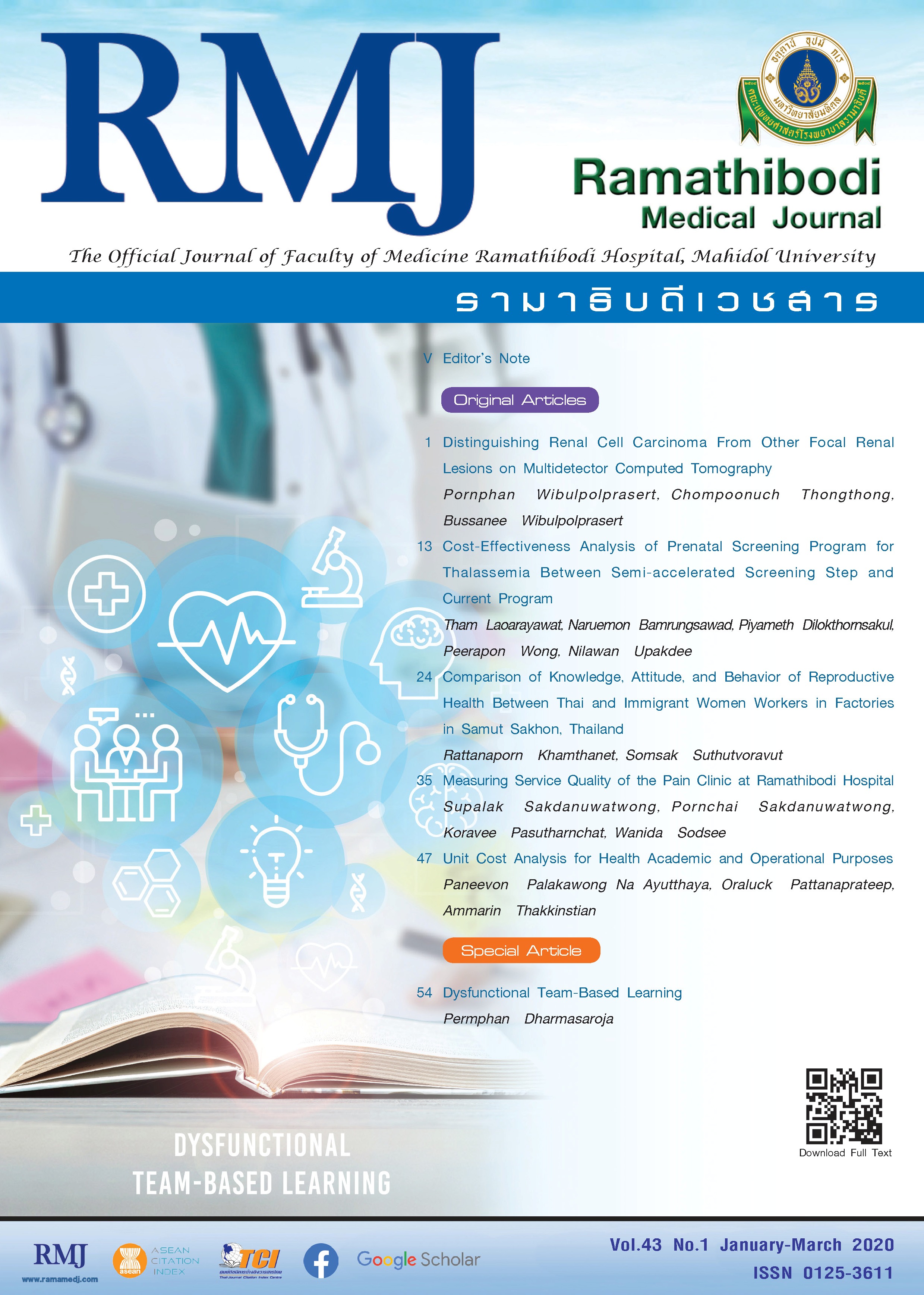Measuring Service Quality of the Pain Clinic at Ramathibodi Hospital
DOI:
https://doi.org/10.33165/rmj.2020.43.1.183794Keywords:
Service quality, Pain clinic, Pain treatmentAbstract
Background: Evaluating gap between patient’s expectation and perception of service quality of the pain clinic through the service quality model is necessary to improve service quality, which will lead to patient’s satisfaction.
Objective: To compare the difference between patient’s expectation and perception of service quality of the pain clinic at Ramathibodi Hospital.
Methods: A survey of patients of the pain clinic at Ramathibodi Hospital using the service quality questionnaire. The sample consisted of 266 patients who received pain treatment services from August 11, 2016, to December 10, 2016.
Results: Most patients were female (63.16%), married (61.28%), educational level lower than bachelor degree (57.52%), monthly income ≤ 30,000 Thai Baht (75.56%), attended treatment service more than 3 times (85.34%), and average age 56.47 ± 16.27 years. Overall expectation and perception and 4 subservice dimensions (tangible, reliability, responsiveness, and assurance) were not statistically significant. Empathy perceived higher than expectation. However, patients perceived the modern tool and equipment used in providing treatment services lower than expectation.
Conclusions: Overall service quality and 4 sub service dimensions of tangible, reliability, responsiveness, and assurance of the pain clinic met expectation. Empathy was higher than expectation, while modern tool and equipment used in the clinic were lower than expectation.
References
Parasuraman A, Zeithaml VA, Berry LL. A conceptual model of service quality and its implications for future research. J Mark. 1985;49(4):41-50. doi:10.2307/1251430.
Babakus E, Mangold WG. Adapting the SERVQUAL scale to hospital services: an empirical investigation. Health Serv Res. 1992;26(6):767-786.
Curry E, Sinclair A. Assessing the quality of physiotherapy services using SERVQUAL. Int J Health Care Qual Assur. 2002;15(5):197-205. doi:10.1108/09526860210437412.
Parasuraman A, Zeithaml, VA. Berry LL. SERVQUAL: a multiple-item scale for measuring consumer perceptions of service quality. J Retail. 1988;64(1):12-40.
Anderson EA, Zwelling LA. Measuring service quality at the university of Texas M.D. Anderson cancer center. Int J Health Care Qual Assur. 1996;9(7):9-22. doi:10.1108/09526869610150200.
Sohail MS. Service quality in hospitals more favorable than you might think. Managing Serv Qual. 2003;13(3):197-206. doi:10.1108/09604520310476463.
Jabnoun N, Chaker M. Comparing the quality of private and public hospitals. Managing Serv Qual. 2003;13(4):290-299. doi:10.1108/09604520310484707.
Boshoff C, Gray B. The relationship between service quality, customer satisfaction and buying intentions in the private hospital industry. South Afr J Bus Manage. 2004; 35(4):27-37.
Mostafa MM. An empirical study of patients’ expectations and satisfactions in Egyptian hospitals. Int J Health Care Qual Assur Inc Leadersh Health Serv. 2005;18(6-7):516-532.
Robini R, Mahadevappa B. Service quality in Bangalore hospitals - an empirical study. J Serv Res. 2006;6(1):59-84.
Bakar C, Akgün HS, Al Assaf AF. The role of expectations in patient assessments of hospital care: an example from a university hospital network, Turkey. Int J Health Care Qual Assur. 2008;21(4):343-355. doi:10.1108/09526860810880144.
Khamis K, Njau B. Patients’ level of satisfaction on quality of health care at Mwananyamala hospital in Dar es Salaam, Tanzania. BMC Health Serv Res. 2014;14:400. doi:10.1186/1472-6963-14-400.
Wisniewski M, Wisniewski H. Measuring service quality in a hospital colposcopy clinic. Int J Health Care Qual Assur Inc Leadersh Health Serv. 2005;18(2-3):217-228.
Yousapronpaiboon K, Johnson WC. Measuring hospital out-patient service quality in Thailand. Leadersh Health Serv. 2013:26(4):338-355. doi:10.1108/LHS-07-2012-0023.
Leelataypin K, Maluesri P, Punnakitikashem P. Service quality assessment in public hospital in Bangkok using SERVQUAL model. KMUTT R&D Journal. 2011;34(4):443-456.
Chuen-im W, Sitakalin P, Prasertchai A. Client expectations and perceptions of service quality at Ramathibodi Personnel Healthcare Unit, Faculty of Medicine Ramathibodi Hospital. Rama Nurs J. 2015;21(1):122-138.
Bahadori M, Raadabadi M, Ravangard R, Baldacchino D. Factors affecting dental service quality. Int J Health Care Qual Assur. 2015;28(7):678-689. doi:10.1108/IJHCQA-12-2014-0112.
Parasuraman A, Zeithaml VA, Berry LL. Alternative scale for measuring service quality: a comparative assessment based of psychometric and diagnostic criteria. J Retail. 1994;70(3):201-230. doi:10.1016/0022-4359(94)90033-7.
Turner RC, Carlson L. Indexes of item-objective congruence for multidimensional items. Int J Test. 2003;3:163-171. doi:10.1207/S15327574IJT0302_5.
Tavakol M, Dennick R. Making sense of Cronbach’s alpha. Int J Med Educ. 2011;2:53-55. doi:10.5116/ijme.4dfb.8dfd.
Ketsingha W. Mean and interpretation: simple issues and easy mistake. J Educ Res News. 1995;18(3):8-11.

















